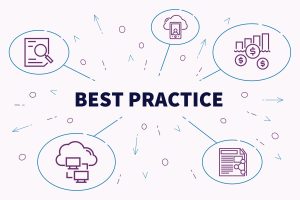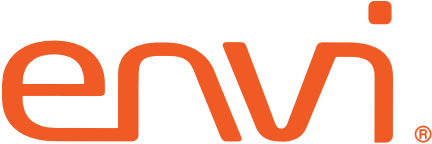Good, Better, Best Practices
We asked IOS business leaders Steve Britt, Managing Partner, and Jeff Lawrence, Vice President of Business Development, to share their thoughts on the newly launched IOS Best Practices Program, and answer a few questions about the value of the program for the industry, the value for IOS customers, and what can we expect to see in the future. Here’s what they had to say…
Q: How did the IOS Best Practices Program come to be?
Steve: Our team talks to IOS customers and industry experts every day.  We’re constantly in discussions that give us real-world insights about what’s changing, what’s working and lessons learned. It’s not new news that in healthcare, we’re all trying to do more with less, trying to find new ways to gain more efficiencies. This year, we decided to build out a formal program that will help our customers and others in the healthcare supply chain immediately connect with insights and ideas to help improve their processes – directly from people on the front line, working to solve the same problems.
We’re constantly in discussions that give us real-world insights about what’s changing, what’s working and lessons learned. It’s not new news that in healthcare, we’re all trying to do more with less, trying to find new ways to gain more efficiencies. This year, we decided to build out a formal program that will help our customers and others in the healthcare supply chain immediately connect with insights and ideas to help improve their processes – directly from people on the front line, working to solve the same problems.
Our goal is to be in partnership with people using our solutions, not just be a “drop and run” technology vendor. Solving the challenges faced by providers takes more than technology – it takes great customer service, cross-functional knowledge sharing, industry expertise, process improvements, and continual innovation to help align today’s best technology solutions with best practices that drive overall performance.
Jeff: Launching our Best Practices Program is something I’ve wanted to do for a few years now. In the conversations I have with leaders at provider organizations, I’m constantly asking them for information about their processes, in order to help solve some of their problems. But I realized that at the same time, they’re asking me for input about what we see at IOS, what’s working, what lessons can be shared. We recognized the great opportunity we have to share ideas and success stories from across our broad base of over 5,000 member organizations and in 2019, we’ve set a goal to continually document and release more Best Practices to help Envi users and others in the industry benefit from the real-world experiences other providers and of IOS.
Q: What are some areas of focus for the Best Practices Program and why?
Steve: We started off with key, fundamental pieces of any supply chain management system – things such as order management, including PO creation, approval and confirmations, then worked on some of the essential elements, like setting up your item master and data collection, then system set-up and configuration. We looked at the areas that would help an organization take quick steps toward immediate improvement.
Jeff: Supply chain has so many components that alone are each important, but together, make or break your system and your results. Once we had the foundational pieces built, we tackled some of the most important areas for automation and efficiency, like setting up inventory area organization, perpetual inventory tracking, receiving, and accounts payable. Throughout each process, we make recommendations at the industry level, solution level and user level, to provide ideas and goals for everyone in the organization, looking broadly across functional areas that make up the end-to-end supply chain.
Q: How will people gain value from the Best Practice program?
Steve: I see value in several areas. First, supply chain leaders will be able to identify areas where taking steps will deliver immediate benefit. We’ve provided suggestions about goal setting, establishing direction for realistic areas of improvement. Next, we’ve worked up and down the supply chain within an organization, to touch all areas where improving processes will improve results. Finally – and most importantly – in today’s healthcare environment, we’re facing one of the most rapid transformations to ever take place. Every day, I see providers propelled by mergers and acquisitions, challenging them to manage across facilities – beyond the four walls of the hospital, across legacy systems. Getting solutions and processes to span these newly formed organizations is a huge challenge, especially as hospitals acquire facilities in the non-acute space, which brings a whole different set of issues. Things we’ve discussed for years – especially aligning people, process and technology – is now game-changing. Best Practices will support these critical activities and help prepare organizations for the future, managing across new complexities.
Q: What can we expect to see in the future?
Jeff: Provider organizations want to grow their supply chain sophistication and need solutions that extend the capabilities of their team. People who were previously operational now need to grow their strategic capabilities, and use everything available to them to help them improve. This often includes things like reporting tools that support planning, forecasting and management processes.
The IOS team works in close partnership with member organizations, so we see firsthand the supply chain challenges and gaps that come up most often. We’ve taken on these topics and documented the Best Practices that help improve and standardize these areas, and we’re committed to adding more, which will roll out throughout the year. We’ve also integrated Best Practices into our internal workflow. For example, our sales team uses Best Practices to assess an organization’s current state and understand their specific needs and goals. Our implementation team uses Best Practices to identify current processes, set up systems correctly, support internal team alignment, and prepare for success through internal communication. We make sure new organizations coming on board with the Envi solution are set up for success.
We’ll keep developing new Best Practices based on what we see and hear from our partners, and keep making them available to everyone in the industry, so we can all share and benefit from what’s working at IOS member organizations.
Interested in learning more about the IOS Best Practices program? Click here for a description of the program, or reach out to us via phone (1 800 700 4467) or email support@localhost.
About the Authors
Steve Britt
Managing Director
Inventory Optimization Solutions (IOS)
With over 25 years in the healthcare industry, Steve Britt is the Managing Director at Inventory Optimization Solutions (IOS). Steve joined IOS in 2004, bringing expertise in healthcare supply chain management technology, built during his extensive experience at companies including Revelocity and Neoforma. Today, Steve focuses on helping healthcare organizations improve their overall performance by creating greater automation of business processes.
At IOS, Steve’s commitment is to ensuring customers achieve value from the company’s solutions, working together in partnership with provider organizations across the continuum of care. With a track record of helping organizations build supply chain success, Steve enables organizations to share best practices and use technology to improve business processes to drive efficiencies, automation and results.
Jeff Lawrence
Vice President of Business Development
Inventory Optimization Solutions (IOS)
With a substantial background in healthcare supply chain technology, Jeff Lawrence joined Inventory Optimization Solutions (IOS) in 2009 as the Vice President of Business Development. For over 20 years, Jeff has focused on leveraging supply chain technology to build a more efficient and sustainable healthcare industry. With hands-on experience helping providers implement technology to improve business processes, Jeff works in partnership with his customers, sharing best practices to increase automation and improve overall business results. Jeff’s career has included roles in business development and sales, along with finance, implementation, operations, and strategy development. He brings a strong blend of customer focus, business strategy, innovation and execution, which helps IOS quickly and efficiently deliver inventory and supply management solutions to provider organizations throughout the continuum of care.

